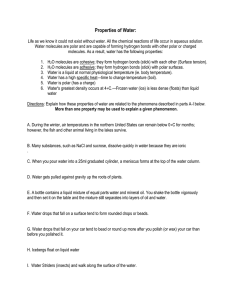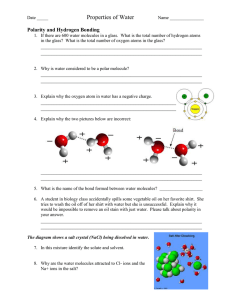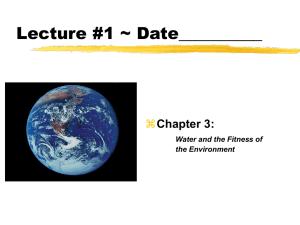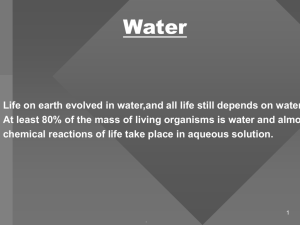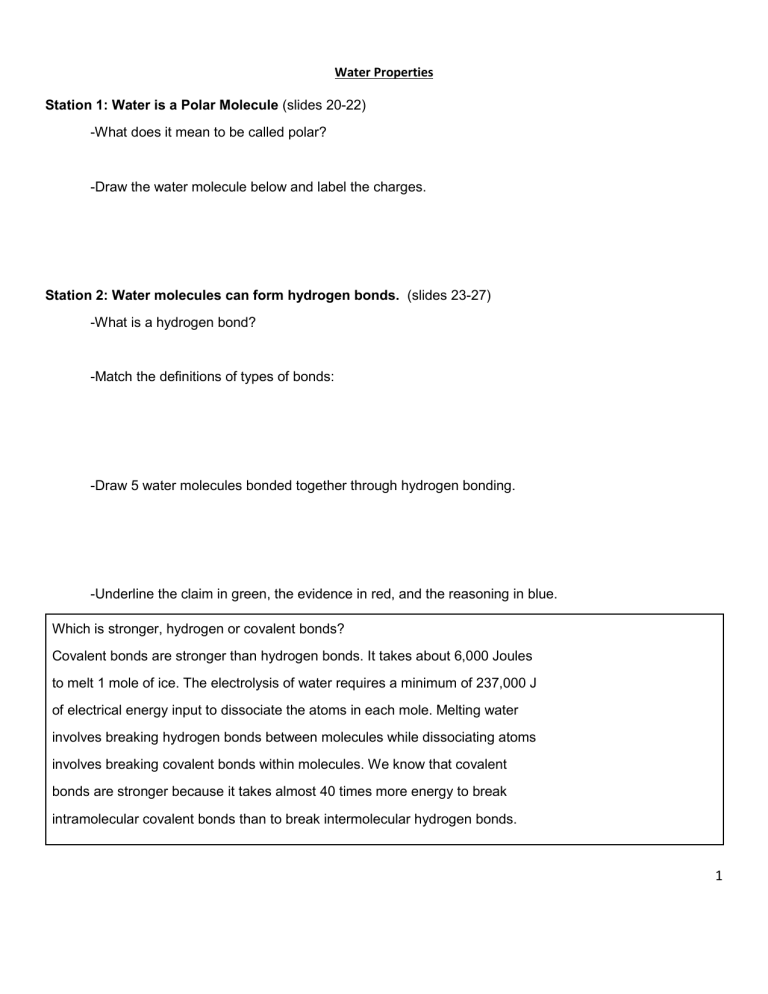
Water Properties Station 1: Water is a Polar Molecule (slides 20-22) -What does it mean to be called polar? -Draw the water molecule below and label the charges. Station 2: Water molecules can form hydrogen bonds. (slides 23-27) -What is a hydrogen bond? -Match the definitions of types of bonds: -Draw 5 water molecules bonded together through hydrogen bonding. -Underline the claim in green, the evidence in red, and the reasoning in blue. Which is stronger, hydrogen or covalent bonds? Covalent bonds are stronger than hydrogen bonds. It takes about 6,000 Joules to melt 1 mole of ice. The electrolysis of water requires a minimum of 237,000 J of electrical energy input to dissociate the atoms in each mole. Melting water involves breaking hydrogen bonds between molecules while dissociating atoms involves breaking covalent bonds within molecules. We know that covalent bonds are stronger because it takes almost 40 times more energy to break intramolecular covalent bonds than to break intermolecular hydrogen bonds. 1 Station 3: Water is less dense as solid as a liquid. (slides 27-30) -What causes the density changes? -How does this benefit living organisms? -What is difference of ice in water versus alcohol? -How would life on Earth be affected if water was less dense than ice? Write your idea and the idea of two other people. -Grade the following CER using the rubric on slide 17. Prompt: A farmer hears a news report regarding a frost advisory for his region. To protect his strawberry plants, he decides to spray water on the crops prior to the frost that evening and early morning. Using your knowledge of the structure of water and its properties, justify (AP vocabulary for “make a claim and provide supporting evidence and reasoning”) the farmer’s reaction to the frost advisory by explaining how one of the emergent properties of water fit this example. CER: Ice insulates and protects the strawberries due to its lower density as a solid than a liquid. The density of liquid water is 997 kg/m3 and the density of frozen water is 917 kg/m3. Empty space prevents heat convection - the loss of heat through movement of air molecules. Conduction at the surface of the ice is the only way to lose heat which is a slower way to lose heat. The water molecules in frozen water are moving slowly enough to form the maximum number of hydrogen bonds which causes the molecules to expand into a rigid lattice with gaps between the molecules. There is more empty space in ice and the spaces giving ice its greater lower density prevent heat loss by convection. Station 4: Water can absorb a lot of heat. (slides 31-34) -How does hydrogen bonding cause water to absorb so much heat? -What are the benefits to ecosystems of this property. -Grade and correct the following CER using rubric on slide 17. Question: Which liquid is most likely water? 2 Claim: It is #1. Evidence: Liquid 1 has a freezing point of 32. Reasoning: Water has a freezing point of 32. This is the same as liquid 1. Station 5: Water molecules are cohesive. (slides 35-38) -What is cohesion? -What are surfactants? -What is adhesion? -How do cohesion and adhesion work together? Why would this property be important for plants? -How is the glass tube different from the straw? - Complete the penny experiment. Create your data table below. **Can you complete the paperclip challenge? What is an organism that uses this property? -Write a CER statement Which liquid from the penny experiment has the most surface tension? 3 Station 6: Water is the universal solvent. (slide 39-44) -What makes water the universal solvent? -Why is this helpful for living things? -What makes some molecules hydrophilic? -What makes some molecules hydrophobic? -Write a CER Statement Is water truly a “universal solvent?” 4 Properties of Water Lab Content Standards: EU 2. A. 3: Organisms must exchange matter with the maintain organization. For more help with the concepts in this lab, visit www.bozemanscience.com/ap-biology/ and watch the AP Biology Water: A Polar Molecule video. Also visit www.bozemanscience.com/statistics-graphing/ and watch the Standard and Standard environment to grow,Deviation reproduce, and Error videos. SP2: The student can use mathematics appropriately. SP5: The student can perform data analysis and evaluation of evidence. SP6: The student can work with scientific explanations and theories. Background Information: Water is a polar molecule. The oxygen atom in water has a greater electronegativity, or a stronger “pull,” on the electrons that it shares with the two hydrogens it is covalently bonded to. As a result, the molecule ends up having a partially negatively charged end, near the oxygen, and a partially positively charged end near the hydrogens. Much like a magnet, opposite charges will attract and similar ones will repel so that the slightly negatively charged oxygen of one water molecule will be attracted to the slightly positively charged hydrogen of a neighboring water molecule. This weak attraction and “sticking together” of polar molecules is called hydrogen bonding. Water is an extremely important molecule in biology. Life came from the earliest watery environments, and thus all life depends upon the unique features of water which result from its polar nature and ‘stickiness.’ Some of the unique properties of water that allow life to exist are: ● ● ● ● ● ● It is less dense as a solid than as a liquid. It sticks to itself –cohesion– cohesion is also related to surface tension. It sticks to other polar or charged molecules –adhesion– adhesion results in phenomea such as capillary action. It is a great solvent for other polar or charged molecules. It has a very high specific heat –that is, it can absorb a great deal of heat energy while displaying only small increases in temperature. It has a neutral pH of 7, which means the concentrations of H+ and OH- ions are equal. 5 Introduction to Statistics: Statistical analysis is used to collect a sample size of data which can infer what is occurring in the general population. Standard deviation (often reported as +/-) shows how much variation there is from the average (mean). If data points are close together, the standard deviation with be small. If data points are spread out, the standard deviation will be larger. Typical data will show a normal distribution (bell-shaped curve). In normal distribution, about 68% of values are within one standard deviation of the mean, 95% of values are within two standard deviations of the mean, and 99% of the values are within three standard deviations of the mean. The formula for standard deviation is shown to the below, where is the mean, xi is any given data value, and n is the sample size. Consider the following sample problem. x Grades on the most recent AP Biology quiz were as follows: 96, 96, 93, 90, 88, 86, 86, 84, 80, 70. x Step 1: Find the Mean ( ). _____________ x Step 2: Determine the Deviation (xi - )2 from the mean for each value and square it, then add up all of the total values. ______________ Step 3: Calculate the Degrees of Freedom (n-1). ______________ Step 4: Put it all together to find s. _______________ In the problem above, the mean is 87 and the standard deviation is 8. So one standard deviation would be (87-8) through (87+8), or 79-95 (68% of the data should fall between these numbers). Two standard deviations would be (8716) through (86+16), or 71-103 (95% of the data should fall between these numbers). Three standard deviations would be (87-24) through (87+24), or 63-111 (99% of the data should fall between these numbers. 6 Standard error of the mean is used to represent uncertainty in an estimation of mean and accounts for both sample size and variability. The formula used to calculate standard error of the mean is shown below. As standard error grows smaller, the likelihood that the sample mean is an accurate estimation of the population increases. Using the data from the standard deviation example above, the mean is 87 and the standard deviation is 8. Plug in the numbers (remember that n is 10), and the standard error of the mean equals 2.5 This means that measurements vary by +/- 2.5 from the mean. It is common practice to add standard error bars to graphs, marking one or two standard error(s) above and below the sample mean (see figure to the right). Such bars give an impression of the precision of estimation of the mean in each sample. Typically, the length of the bars above and below the mean and the overlap of the bars as compared to one another is analyzed (see figures to the right). The length of the bars shows the spread around the mean. Shorter bars indicate less variability from the mean. If two or more error bars are the same size, they have similar spreads around their means. If a bar is longer than others, it has a larger spread around its mean. When the range of bars overlaps, this indicates that there is NOT a significant difference in averages and data sets. If the range of bars does not overlap, there may be a significant difference in averages and data sets (a t-test must be done to further the investigation). Notice that in the last image, the error bars tell us that we can be 95% confident (2 SEM) that the Greenies mean IQ is significantly different from either the Reddies or the Yellowies. Things are not nearly so clear-cut between the Reddies and the Yellowies. Notice how the error bars of the Reddies and Yellowies overlap, but there is clearly no overlap between both of them and the Greenies. Question: How does soap affect hydrogen bonds between different water molecules? Hypothesis: Materials: Penny, distilled water, soap, pipette, paper towel Safety: Soap can be an irritant. Take caution to avoid contact between soap and eyes. Procedure: 1. Obtain a DRY penny and place it on a DRY paper towel. 2. Using a clean pipette, add distilled water to the penny drop by drop until it overflows. Be sure to count the drops! Record the number of drops for Trial 1 in Data Table 1 below. 3. Repeat steps 1-2 for a total of five trials. 4. Obtain a DRY penny and place it on a DRY paper towel. 5. Spread a thin layer of soap on the penny. 7 6. Using a clean pipette, add distilled water to the penny drop by drop until it overflows. Be sure to count the drops! Record the number of drops for Trial 1 in Data Table 1 below. 7. Repeat steps 4-6 for a total of five trials. Be sure to add a new layer of soap between trials! Data Collection: Data Table 1: Number of Drops of Distilled Water Contained on the Surface of a Penny Trial # Drops Distilled Water # Drops Distilled Water + Soap 1 2 3 4 5 Average Data Analysis: Do the appropriate calculations in Data Table 2 below. Data Table 2: Statistical Analysis of the Number of Drops of Distilled Water Contained on the Surface of a Penny Calculation # Drops Distilled Water # Drops Distilled Water + Soap Mean Standard Deviation +/- 1 std dev +/- 2 std dev Standard Error +/- 2 SEM Create an appropriately labeled bar graph to illustrate the sample means for the penny with and without soap within 95% confidence (+/- 2 SEM). Don’t forget a title that includes the independent and dependent variables and axes labels with units. Feel free to use Google Sheets to make your graph and then insert the graph here. 8 1. Make a Claim about how soap affects hydrogen bonds between water molecules. 2. Using data from this experiment, provide Evidence that supports the claim. 3. Using background and scientific knowledge and data from this lab, provide Reasoning that uses the evidence to justify the claim. 4. Find an example of how living things use each of the properties of water. 9

